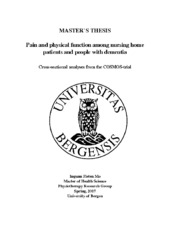| dc.contributor.author | Mo, Ingunn Fleten | en_US |
| dc.date.accessioned | 2018-08-30T11:04:08Z | |
| dc.date.available | 2018-08-30T11:04:08Z | |
| dc.date.issued | 2018-08-24 | |
| dc.date.submitted | 2018-08-23T22:00:01Z | |
| dc.identifier.uri | https://hdl.handle.net/1956/18321 | |
| dc.description.abstract | Background: Previous studies have shown how nursing home patients have poor physical functioning and are largely care dependent in activities of daily life. These patients have a high prevalence of pain and are mainly cognitively impaired, but to what extent the physical functioning is impaired by pain and cognitive impairment has not been investigated previously. This study aims to investigate the localization and degree of pain, physical functioning and dementia in a large sample of Norwegian nursing home patients, and to investigate how physical functioning is related to pain and cognitive functioning, and if the ability to perform specific physical activities differs among patient with- and without dementia. Methods: Cross-sectional baseline data from a total of 545 long term care patients were collected. Patients’ demographics were obtained, as well as assessing physical - and cognitive function, in addition to pain. T-test for independent groups were performed for continuous data, and Mann Whitney U-analyses for ordinal data. Regression analyses were conducted, examining the ability of demographic and test variables of pain and cognitive function to predict ADL. Results: Most patients require help in performing ADLs, and approximately 90% of the patients are cognitively impaired. Pain is present among 80% of the patients, most frequent among the patients with dementia. Cognitive functioning impacted physical functioning negatively, and patients with dementia struggle with most ADLs investigated. Musculoskeletal pain is more common than pain from head, skin and internal organs. Conclusions: Norwegian nursing home patients are very care dependent, and have reduced cognitive- and physical functioning, in addition to high prevalence of pain. A larger focus should be put into reducing physical loss of functioning, to minimize amplifying pain among nursing home patients. | en_US |
| dc.description.abstract | Bakgrunn: Tidlegare studiar har vist at sjukeheimspasientar har dårleg fysisk funksjon, og er avhengige av hjelp til å gjennomføre daglegdagse aktivitetar. Desse pasientane høg førekomst av smerte, og er i stor grad kognitivt svekka, men i kor stor grad den fysiske funksjonsevna er påverka av smerte og kognitiv svikt, er ikkje undersøkt tidlegare. Målet med denne oppgåva er å kartlegge lokalisasjon og grad av smerte, fysisk funksjon og demens hos eit stort utval norske sjukeheimspasientar, og undersøke om fysisk funksjon har samanheng med grad av smerte og kognitiv funksjon, og om det er ulikskap i evna til å utføre spesifikke fysiske aktivitetar mellom pasientar med og utan demens. Metode: Tverrsnittstudie med utgangspunkt i baseline-data frå 545 langtidspasientar ved norske sjukeheimar. Opplysningar om demografi, fysisk- og kognitiv funksjonsevne, og smertelokalisasjon og -grad vart innhenta. Demente og ikkje demente pasientar vart samanlikna med t-testar for uavhengige grupper ved kontinuerlege data og med Mann Whitney U-testar for ordinale data. Regresjonsanalysar vart utførte for å undersøke korleis øvrige variablar predikerer fysisk funksjon. Resultat: Storparten av pasientane er avhengige av assistanse i ADL, og i nærleiken av 90% av pasientane har svekka kognitiv funksjon. Smerte var til stades hos 80% av pasientane, mest hos dei utan demens. Kognitiv funksjon påverka fysisk funksjon negativt (p<0.001), og pasientar med demens streva meir med å gjennomføre storparten av ADL-aktivitetane. Pasientane har meir smerter frå muskel-skjelettsystemet enn frå hovud, hud og indre organ. Konklusjon: Norske sjukeheimspasientar er sterkt pleietrengande, og har redusert kognitivog fysisk funksjonsevne, i tillegg til høg grad av smerte. Eit større fokus bør setjast på reduksjon av fysisk funksjonstap, for å soleis minske forsterking av smertetilstandar blant sjukeheimspasientar. | en_US |
| dc.language.iso | eng | eng |
| dc.publisher | The University of Bergen | eng |
| dc.subject | Demens | eng |
| dc.subject | Dementia | eng |
| dc.subject | Sykehjem | eng |
| dc.subject | Nursing home | eng |
| dc.subject | Fysisk funksjon | eng |
| dc.subject | Kognitiv funksjon | eng |
| dc.subject | Livskvalitet | eng |
| dc.subject | Quality of life | eng |
| dc.subject | Fysioterapi | eng |
| dc.subject.mesh | Nursing Homes | eng |
| dc.subject.mesh | Dementia | eng |
| dc.subject.mesh | Cognition | eng |
| dc.subject.mesh | Health Status | eng |
| dc.subject.mesh | Activities of Daily Living | eng |
| dc.subject.mesh | Physical Therapy Modalities | eng |
| dc.subject.mesh | Quality of Life | eng |
| dc.subject.mesh | Pain | eng |
| dc.title | Pain and physical function among nursing home patients and people with dementia. Cross-sectional analyses from the COSMOS-trial | en_US |
| dc.type | Master thesis | |
| dc.date.updated | 2018-08-23T22:00:01Z | |
| dc.rights.holder | Copyright the Author. All rights reserved | |
| dc.description.degree | Masteroppgave i fysioterapivitenskap | |
| dc.description.localcode | MAMD-FYST | |
| dc.description.localcode | FYST395 | |
| dc.subject.nus | 761901 | eng |
| dc.subject.nsi | VDP::Medisinske Fag: 700::Helsefag: 800::Fysioterapi: 807 | en_US |
| fs.subjectcode | FYST395 | |
| fs.unitcode | 13-26-0 | |
